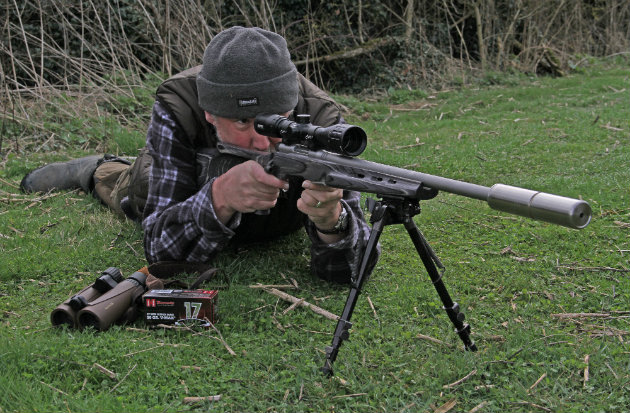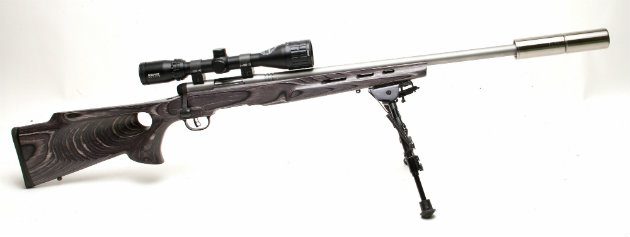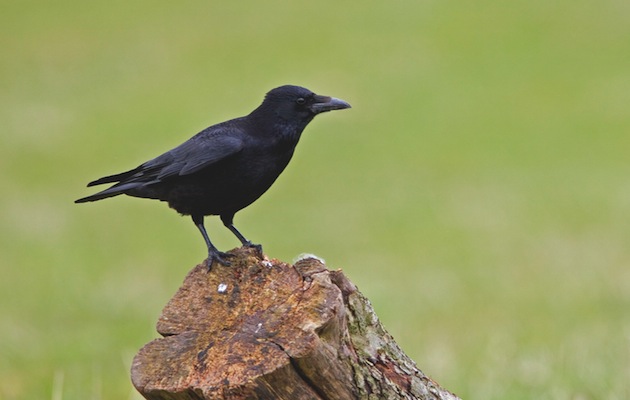Savage B.Mag Target .17 WSM
Front-runner Savage has done it again, this time with a new cartridge to match its latest rifle, but the bolt is distinctly odd, says Bruce Potts

Savage B.Mag Target .17 WSM
Overall Rating: 78%
Manufacturer: Savage
Pros: Excellent accuracy
Price as reviewed: £865
Cons: No left-hand version in this format
I have tested many a Savage over the years and have seen them transform from a budget-priced yet reliable and accurate rifle from the US to a more respected and accepted gun in Britain today. This is largely due to the efforts of importer Edgar Brothers, which offers the Savage range. Savage has also been a front-runner when it comes to taking up the mantle for newer cartridges that emerge on to the market such as the 6.5 Creedmoor, 17 HMR and .17 Hornet rounds. This offers the British shooter a new cartridge in a reasonably priced rifle.

Savage is at it again with the advent of the new Winchester .17 WSM (Winchester Super Magnum) round. When I say “new”, the Americans have had it since 2013 but as always we have to wait for it to arrive here. Savage has introduced it in its new rifle, the B.Mag, which is a departure from its usual fare. Though it is a traditional format of a bolt action with detachable magazine and laminate stock for sporting use, it uses a medium-heavy varmint/target barrel for better accuracy and has a completely new action design.
I took the Savage to the shooting bench to give it a workout regarding reliability and accuracy, then tested it at extended ranges to see the ballistic limits. I also shot into ballistic media to ascertain the cartridge’s performance and finally took it out to shoot some troublesome crows.
Workings
First, let’s look through the workings of this new rifle and the cartridge that inspired it. The B.Mag comes in six models and I prefer this Target version. The action and a barrel are stainless steel, with the barrel length not too long at 22in and screw cut for a 1/2in x 20 UNF thread. Being a medium-weight semi-varmint/target profile, the Savage sits very well in the hand and balances the rifle nicely. It is free-floated along its length to enhance accuracy due to consistent barrel harmonics. The action comes with Weaver-type bases for a scope mount and the detachable magazine is handy and pretty standard now. It is a rotary type so it sits flush with the level of the stock and holds an impressive eight rounds; with one in the chamber that’s nine shots on tap. It was reliable throughout the tests.

Rear-locking lugs are a good idea but Savage needs to re-think the design as it is awkward
The excellent Accutrigger adorns most Savage rifles now and is synonymous with safety as well as a great light and predictable trigger-pull. This model broke at a weight of 2.75lb and can be adjusted to suit your own needs. Safety-wise a silvered safety lever is sited in the tang so a thumb from the firing hand can simply and quietly pull back for on and forward for off.
The bolt system, however, is very odd indeed. The bolt handle resembles an engine from a Me 262 jet fighter with lozenge-shaped and hollow form. The actual bolt action or manipulation is equally unusual. It cocks the firing pin on closing and has two rear locking lugs, and is strange and awkward to operate. The bolt does not rotate so when you push forward to load a cartridge the bolt handle can drop before it is in the action recess. Closing the bolt is strained and feels very delicate.
The stock, on the other hand, is very good. A Boyd laminate thumbhole model, it has alternate layers of grey and black wood epoxied together for strength and to stop warping in inclement weather. It handles very well, the thumbhole design gives a sure grip and the extended and fore-end, ventilated for heat dispersal, also has a firm grip — very nice.
Field tests
Ballistics or ballistic advantage is where Winchester pitched its new baby as it wanted to elevate some of the troubling split case problems associated with the .17 HMR as well as increase performance so that it would topple the HMR and to some extent, the .22 WMR.
Quoted figures are one thing, shooting in the field is another and the only true way to test a new cartridge’s performance out in the field where terrain undulates and wind and rain make for a real-world test.
Winchester states that the .17 WSM round is capable of 3,000fps velocity for 400ft/lb energy from the 20-gr V-Max bullet. A .17 HMR 20-gr equivalent is 2,450fps, so 550fps better for the WSM. Believe it or not, the .17 WSM round is based on the 0.27 nail-gun case used by builders worldwide. It has a larger capacity and, importantly, a stronger case to cope with the higher pressures generated.

The bolt system is very odd and has resulted in a lower score for this Savage Arms offering
At the moment you only have one choice of projectile, the 20-gr V-Max from Hornady, available but Winchester does make a 25-gr HE (2,600fps) and 20-gr JHP round (3,000fps). Being a rimfire, it is not reloadable so you are stuck with this choice, but it simplifies things. It makes you learn just one load’s performance — the trajectory downrange and how much it blows in the wind — so it will become second nature. I like reloading to get the best from a rifle but have to agree it is sometimes nice simply to pick up a box of factory rounds and go.
.17 HMR bolt-action rifles
Flat shooting and fast expanding, the .17 HMR round is a popular vermin control cartridge. This guide rounds up the…
Savage 93R17 BTVS .17 HMR rifle review
Savage 93R17 BTVS .17 HMR rifle review: This trim and handy HMR rifle ticks all the boxes. It’s a reliable…
.17HMR calibre sound moderators review
.17HMR calibre sound moderators: .17HMR sound moderators are increasingly popular due to the proliferation of this calibre. Here we take…
Accuracy
Accuracy on the bench was impressive with an array of steel silhouettes set out at 50 to 200 yards range as well as standard paper targets. I had a limited supply of ammunition and at £38.50 for 100 rounds, owners would be mindful of frugal use. Fifty-yard groups were one ragged hole; at 100 yards the 20-gr V-Max grouped three shots into 0.75in and at 200 yards 2in groups were obtainable in light wind conditions.

Testing on the bench over the chronograph to get an idea of the rifle and cartridge’s performance
Penetration or lack of it can always be a problem with fast, light bullets because they can explode on the outer areas of the skin rather than penetrate to the vitals. This 20-gr V-Max is a good choice for penetration and fast expansion with the ballistic media shot at 100 yards shows: the penetration of 1.5in before total expansion with the lead core vapourising and jacket penetrating to 4.5in making a wound channel of 2.5in deep and 2in wide.
Need to know
Model Savage B-Mag
Type Bolt action
Calibre .17 WSM
Action Rear-locking bolt
Magazine Detachable, 8 shot
Finish Stainless steel
Barrel 22in varmint/target profile
Overall Length 42in
Sights Weaver-type base blocks
Stock Grey/black laminate wood
Trigger AccuTrigger
Price £865
Contact Edgar Brothers, tel 01625 613177
No left-hand version in this format

Stalking crows
My primary targets for the .17 WSM were carrion crows. Crows are always a challenge to stalk with a rifle; some bait, some call, but I like to walk and stalk. Here, the weight and handling of the Savage B.Mag is ideal. It’s not heavy , even loaded up with a full magazine, scope and sound moderator. You can carry it on the shoulder with a sling all day without tiredness, and a bipod fitted allows a stalk in then set up for a stable shot.
Sighted in a 100 yards the 20-gr V-Max load travelling at the actual velocity of 2,912fps will be 1.3in low at 150 yards and 4.4in low at 200 yards. The cartridge only rises 0.1in at 75 yards from a barrel 1.5in below the sight line, so good and flat, aim dead on to 125 yards (0.4in low) for a rabbit or crow-sized target, more for a fox. You do have to watch wind drift because at 100 yards with a 90° 10mph wind, the V-Max is shifted 1.6in and at 200 yards it is 7.3in. That’s why setting out steel targets is a great way to learn the wind on your shoot as the visual and audible clang gives confidence.
That’s what transpired with a pair of crows lofted on some thermals circling around a cauldron on the Surrey hills. It’s a bit open and those keen eyes can spot movement or human forms at distance, so I used a hedgerow and gully at the field margin to edge my way towards a vantage point. From here I was 250 yards off, still too far in reality, though the 200-yard steel targets showed accuracy was not an issue.
I wanted to halve the distance and avoid too much compensation for wind that was eddying oddly around the convoluted terrain. I crawled to about 125 yards along a dry ditch, then popped out and set up the bipod when the crows decided to touch ground.
The Bushnell dedicated .17 WSM 4-12 x 40 scope is perfect here as its trajectory compensating reticule design is matched to the .17 WSM ballistics. Thus set, I waited and one of the pair dropped to pick at a leather jacket or some form of carrion on the ground but it was all I needed. The MAE STS Xtreme sound moderator was incredibly quiet and an audible “thwack” echoed the valley as the V-Max hit home. The second crow did a double paddle with its legs in midair to stop its descent and decided to vacate sharpish.
The .17 WSM would be perfect for foxes as it has enough accuracy, penetration and energy delivered to be lethal at more range than a standard .17 HMR round.
Conclusion
This is definitely a rifle of two halves. Accuracy and handling were excellent on the bench and out in the field and the reliability from the magazine equally good. I could not get on with the bolt system, which is a shame because the .17 WSM has the credentials to topple the .17 HMR off its pedestal in the right rifle and fill the gap between .22 Hornet and .223 Rem, where the larger .17 Hornet round never took off.
Score
Accuracy 17/20 Best part of the Savage was the very good accuracy.
Handling 13/20 Stock is fine but that bolt needs a total re-think.
Trigger 17/20 AccuTriggers are always good, enough said.
Stock 17/20 Practical thumbhole and practical sporting finish that handles very well in all weathers.
Value 14/20 It has a lot of good features but that bolt!
Total 78/100
Verdict
It has a lot of good features but that bolt!











